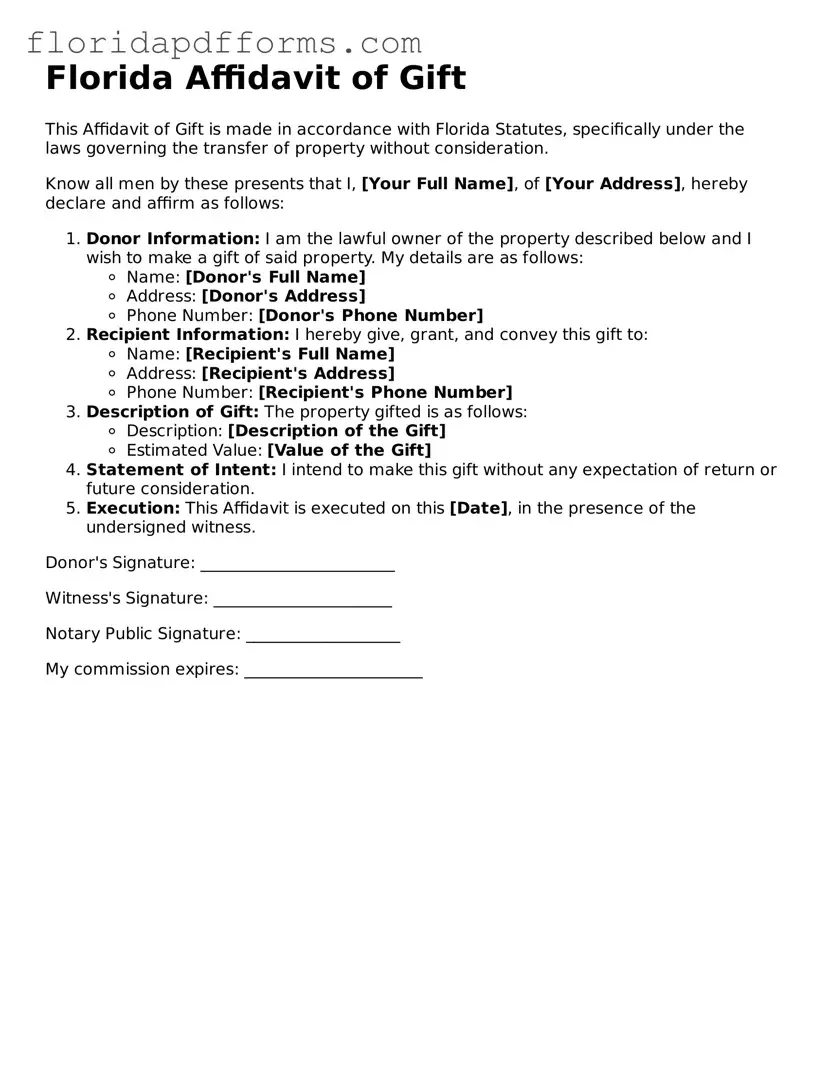The Florida Affidavit of Gift form shares similarities with the Bill of Sale. Both documents serve to transfer ownership of property from one party to another. In a Bill of Sale, the seller provides a written acknowledgment of the sale, while the Affidavit of Gift confirms that the transfer is a gift, not a sale. Each document typically includes details about the property, the parties involved, and the date of the transaction.
Another document akin to the Affidavit of Gift is the Warranty Deed. A Warranty Deed transfers real estate and guarantees that the seller has clear title to the property. Like the Affidavit of Gift, it requires the seller to affirm that they are transferring ownership. Both documents aim to protect the rights of the new owner, ensuring that they receive what they are entitled to without hidden claims or liens.
The Quitclaim Deed is also similar to the Affidavit of Gift. This document transfers interest in real estate but does not guarantee that the title is clear. While the Affidavit of Gift confirms that the property is given without compensation, the Quitclaim Deed simply relinquishes any claim the seller may have. Both documents require the parties' signatures and are often recorded with local authorities.
The Gift Tax Return (Form 709) is another relevant document. This form is filed with the IRS to report gifts that exceed the annual exclusion amount. While the Affidavit of Gift serves as a declaration of the gift itself, the Gift Tax Return addresses the tax implications of that transfer. Both documents help in tracking gifts for legal and tax purposes.
Similar to the Affidavit of Gift is the Power of Attorney document. This legal instrument allows one person to act on behalf of another. While the Affidavit of Gift is focused on the transfer of property, a Power of Attorney can facilitate various transactions, including gifts. Both documents require clear identification of the parties and the scope of authority being granted.
The Trust Agreement is another document that aligns with the Affidavit of Gift. A Trust Agreement outlines how assets are to be managed and distributed. If a gift is made through a trust, the Affidavit of Gift may accompany the Trust Agreement to clarify the intent behind the gift. Both documents ensure that the donor's wishes are respected and legally recognized.
The Donation Receipt is also comparable to the Affidavit of Gift. This receipt is typically issued by a charity when a person donates property or money. Similar to the Affidavit of Gift, it serves as proof of the transfer and can be used for tax deductions. Both documents validate the act of giving and provide necessary information for record-keeping.
The Assignment of Benefits form is another document that bears resemblance to the Affidavit of Gift. This form is used in insurance claims to transfer benefits from one party to another. While it is often used in a commercial context, the underlying principle of transferring rights is similar to that of gifting property. Both documents require the consent of the parties involved and are legally binding.
Lastly, the Release of Liability form can be compared to the Affidavit of Gift. A Release of Liability is signed to absolve one party from future claims related to a specific action. While the Affidavit of Gift does not release liability, it does signify that the giver relinquishes all claims to the property being gifted. Both documents are essential in clarifying the intentions of the parties and protecting their interests.
